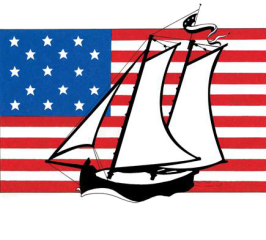You’ll see… Lynch Park!
In light easterly or westerly winds, FAME often sails north out of Salem Harbor in the direction of Beverly, tacking off Lynch Park or Hospital Point [see Hospital Point blog]. Beverly was a port town in Colonial days, although never as busy as Salem, Marblehead, or Gloucester. The location of its small harbor, half a…
Five Top Things You’ll See on your Salem Cruise!
You’ll see the sails go up… and the captain turn off the motor! Yes, we really do sail our traditional wooden schooner, and we love the reaction we get when our guests realize that the wind alone is powering our progress through Salem Sound! One of our skippers calls out “Welcome to the 19th century!”…
Gunnery Innovations of the War of 1812
Wars provide huge incentives for combatants to develop new weapons, new tactics, and new strategies. During the 18th century a new type of cannon had been developed — the carronade. A six-pound carronade would look resemble a traditional six-pound cannon on a carriage, except that the cannon barrel had been dramatically shortened, and the carriage…
Does FAME really have cannon?
Our FAME has two swivel guns: small cannon that are mounted on the rail and can be quickly aimed and fired. They are cast-iron guns that fire black powder, ignited by a musket cap. We often fire the cannon as demonstration during our cruises. No, we do NOT fire cannon balls or grapeshot! We know…
What did sailors eat and drink in 1812?
For long voyages, food needed to be preserved somehow, and that meant salted, pickled, smoked, or dried. Many foods cannot be preserved with these methods, which meant that the sailors’ diet was pretty monotonous. Within a week of leaving port, the fresh provisions were gone, and meals consisted of the same items over and over….
What did Salem Harbor look like in 1812?
Salem was one of the busiest harbors in the country in 1812. There were several long wharves and piers stretching far out into the harbor. These wharves were covered with warehouses and work sheds. During the War of 1812, the fort on Winter Island was put back into fighting shape, and vessels entering the port…
What did the schooner HANNAH do?
Beverly, across the river from Salem, was used by George Washington during the early days of the Revolution as a base for schooners which were leased by the Continental Army, manned by local militia, and sent out to try to capture the ships bringing firewood, food, and other supplies to the British forces in Boston….
What was impressment?
One of the major American complaints leading up to the War of 1812 was that the British, desperate for sailors to man their ships, were kidnapping American citizens on the high seas and forcing them to serve in the Royal Navy. While this was certainly happening, it is more complicated than that. At the time,…
You’ll see… Children’s Island!
Children’s Island is owned by the Marblehead YMCA, which offers summer camp sessions every summer. It was previously known as Cat Island and briefly Lowell Island, when it had a 100-room resort hotel. The hotel became a children’s sanitarium in 1878. A hundred years earlier, a hospital had been built on the island to inoculate…
Wait — what shipwreck?
The shipwreck that lies between Great and Little Misery is the steamer CITY OF ROCKLAND. Built in 1900, she was 274’ long and weighed 1700 tons. She had a checkered 23-year career carrying people up and down the New England coast, including groundings, a collision, and sinking at a Boston dock. After her last grounding,…
You’ll see… the Misery Islands!
Misery Island is the biggest island in Salem Sound, over 80 acres. It’s currently owned by the Trustees of Reservations, but it used to be home to 25 summer cottages as well as a resort featuring piers, clubhouse, saltwater swimming pool, and a nine-hole golf course. The resort (and many of the cottages) burned in…
Who Won the War of 1812?
Britain could claim they had never wanted to fight the US, and had successfully defended Canada. The US could boast they had managed to stave off the much more powerful British. The people who never recovered were the Native Americans, who mostly had sided with the British. Indian lands in the Midwest and Southeast were…
